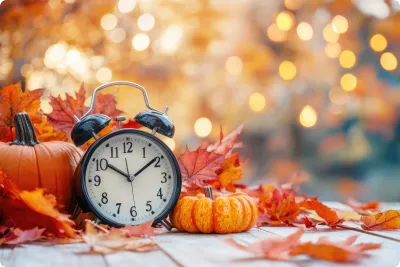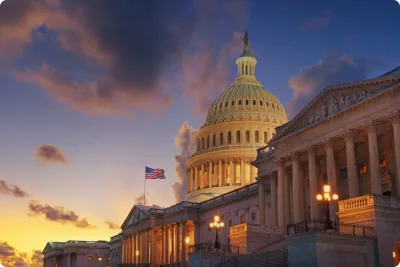November Daylight Saving Time Fall Back: Embrace the Extra Hour
Ana Marie Schick: Resident Sleep Expert and Certified Health Coach • Oct 13, 2025

Key Takeaways
The end of Daylight Saving Time offers a built-in chance to reset your sleep—if you use it wisely.
- When Daylight Saving Time ends in November, you gain an extra hour of sleep, which is best used for rest rather than late-night screen time.
- The fall-back shift can support circadian rhythm realignment when paired with consistent bedtimes and wake times.
- Using the time change as a reset point makes it easier to refine bedtime routines, manage light exposure, and support better sleep habits.
- Adjusting bedroom temperature during this transition can further support sleep quality and comfort.
- Smart sleep technology like the Chilipad Dock Pro helps smooth time-change transitions with precise, consistent temperature control.
As the leaves turn to vibrant hues and the air takes on a crisp chill, we know that autumn is in full swing. But beyond the visual transformation of the season, there's another annual event that's around the corner: the end of Daylight Saving Time (DST). When we "Fall Back," we gain a precious extra hour—an hour that can be used wisely to improve our sleep health and well-being.
In this article, we'll explore how to embrace that additional hour and how to re-adjust your circadian rhythm disturbance.
Before diving into how Fall Back daylight saving can affect your sleep, let's first understand what, why, and when daylight saving time occurs.
What is Daylight Saving?
Daylight saving time is a practice done annually in which clocks are moved forward one hour between March and November to preserve daylight, as the days become darker more quickly in the late fall and winter months than in the spring, summer, and early fall.
While most of the United States observes DST, two states don’t observe daylight savings time, Arizona and Hawaii. [1]
Lock In Your Perfect Sleep Temp
Time shift can still throw off your body's internal clock. Optimize the single most important factor for deep sleep—your core body temperature—with a Chilipad Dock Pro or Cube.
Why Do We Have Daylight Saving Time?
There are a few reasons why we have daylight saving time.
The first reason for Daylight Saving Time is to save energy. During the summer months, the sun rises earlier and sets later. This means that we need less artificial light in the morning and evening. We can reduce electricity use by moving our clocks ahead one hour to get more natural sunlight.
Second, it was put in place to help reduce crime rates. Research has shown that during the evening when there is more daylight, there is a decrease in crime. [2] This could be because people tend to be more active when there is more light outside.
By advancing the clocks forward by an hour, we can gain an extra hour of daylight in the evening and possibly lower the incidences of crime. However, today, research is unclear whether or not that is still true in a post-industrial society.
Some people prefer longer daylight hours in the evening because it gives them more time for outdoor activities like sports, gardening, or taking a leisurely walk after work. Having more daylight in the evening can also help them relax and unwind, positively impacting their mental health and overall well-being.
Related Blog: Year-Round Daylight Saving Time vs Standard Time
When to Change Daylight Saving Time
Many often ask, "When does daylight saving time start?" or "What time does it begin?" Although the exact date varies each year, daylight saving time in the United States always starts at 2 a.m. on the second Sunday of March (Spring Forward) and ends at 2 a.m. on the first Sunday of November (Fall Back).
Switching to Daylight Saving Time in the dead of night on the weekend is intended to cause minimal disruption to our daily routine. This method of switching does not interfere with work and other daytime activities. However, the biannual change in our circadian rhythm hurts our regular sleep schedule, leading to sleep disturbances and disrupting our internal body clock.
The idea behind switching in the dead of night on the weekend is to cause as little disruption in our lives as possible. This may be the case during daylight hours—by doing it this way. For example, it doesn’t interfere with work. But this biannual disruption of our circadian rhythm wreaks havoc on our regular sleep schedule.
Did You Know: Research shows that people may experience mild effects, including difficulty adjusting to a new wake-up time. [3]
Why Can It Be Hard to Fall Asleep?
It can be challenging to fall asleep during the November "Fall Back" time change, which marks the end of Daylight Saving Time, for a few reasons, including:
Disrupted Circadian Rhythm
Our bodies have an internal biological clock that regulates our sleep-wake cycle. Setting our clocks back an hour can disrupt this natural rhythm, making it harder to fall asleep at the new, earlier bedtime.
Delayed Light Exposure
As we set the clocks back an hour, the days get shorter and darker earlier in the evening. This reduction in exposure to natural sunlight can decrease melatonin production, a hormone that regulates our sleep. The reduction can make it harder to feel sleepy at the adjusted bedtime.
Shift in Daily Routine
Any time change, even by just one hour, can lead to a temporary shift in our daily routines, confusing our bodies and making it challenging to fall asleep at the new bedtime.
How to Adjust to Daylight Saving Time?
Adjusting to daylight saving time can be a different experience for everyone. Some people are lucky enough to adapt within a few days, while others may take a few weeks. As we transition to 'Fall Back' and gain an extra hour in November, here are a few tips that can help make the adjustment process smoother:
Gradually Modify Your Bedtime Routine
To help you prepare for DST, it’s best to adjust your sleep slowly. For example, if you regularly go to bed at 10 p.m. each night, five days before, you can divide that hour into five equal chunks.
On the first day, try going to bed 12 minutes later than usual, and then do the same on the second and third days. By the fourth day, you'll be going to bed 12 minutes later than expected, making it easier to adjust to the time change when it happens.
10 p.m. Bedtime Example
- 5 Days Before Fall Back: Go to bed at 10:12 p.m.
- 4 Days Before Fall Back: Go to bed at 10:24 p.m.
- 3 Days Before Fall Back: Go to bed at 10:36 p.m.
- 2 Days Before Fall Back: Go to bed at 10:48 p.m.
- 1 Day Before Fall Back: Go to bed at 11 p.m.
The above schedule shows the recommended bedtime for each day of the week, with a 12-minute later bedtime each consecutive day. This gradual shift can help your body adjust and improve sleep quality leading up to DST
Sleeping Tip: It’s best to go to bed and wake up simultaneously each day, even on the weekends.
Reclaiming Your Time and Sleep
When DST comes to a close, it's as if you've stumbled upon a hidden stash of time. You can choose how to spend it, and the possibilities are endless. Here are some meaningful ways to reclaim that extra hour while also supporting your sleep health:
Reflect and Reconnect:
Consider using this time for reflection and connection. Spend a few moments journaling your thoughts or meditating. Reach out to loved ones you may not have seen in a while. A heartfelt phone call or message during the day can bridge distances and strengthen bonds.
Practice Self-Care:
Indulge in some well-deserved self-care. Run a warm bath, enjoy a spa night, or simply curl up with a good book. Prioritize activities that relax your mind and body, making it easier to fall asleep.
Read More: Reading Before Bed, Can It Help You Fall Asleep?
Step Into Nature:
Autumn's beauty is spectacular. Take a brisk walk in the crisp fall air, visit a nearby park, or simply sit on your porch and savor the season's sights, sounds, and scents. Exposure to natural light during the day can help regulate your circadian rhythm and improve sleep quality.

Keep Naps Short
Even though we gain an hour of sleep, some people go to bed later because they aren’t as tired. This can cause them to feel groggy the next day. Taking a short nap during the day may help you feel better. Experts suggest that the nap should not last more than 20 minutes to avoid feeling more tired and groggy when you wake up. [4]
For more information to help you understand more about the ideal length of naps, read "How Long You Should Nap."
Napping Tip: Try not to take a nap too close to bedtime, as it may affect that night's sleep.
Limit Alcohol and Caffeine
It is advisable to refrain from or restrict the intake of caffeine and alcohol. These substances can have adverse effects on sleep for certain individuals, so limiting their consumption at least 4-6 hours before going to bed is recommended.
As daylight saving time approaches, experts recommend reducing your caffeine intake in the afternoon and gradually decreasing the total amount of caffeine you consume in the days leading up to DST. Avoiding tobacco close to bedtime is also advisable, as it can adversely affect your sleep quality.
Learn more about how alcohol can affect your sleep.
Stay Active
Engaging in regular physical activity can lead to improved sleep quality. To help your body adjust to a time change, it's a good idea to start exercising earlier. Regular exercise during the day can improve the quality of your sleep, whether you prefer walking, running, or riding a bike. [5]
Exercise earlier to help your body adjust to the time change. Start with 30-minute sessions a few times a week and gradually increase duration, but avoid exercising too close to bedtime.
Invest in a Bed Cooling System
As we learned, daylight saving time can disrupt sleep for some people. At Chilipad by sleepme, we make it easy to control your bed temperature with the help of our natural, hydro-powered bed cooling systems.
Whether you select the Chilipad Dock Pro or Chilipad Cube, these bed cooling systems allow you to control the temperature of your mattress topper, allowing you to sleep at your preferred temperature.
Learn more about the benefits of sleeping cooler.
Final Thought
As the clock turns back and you gain an extra hour, remember that time is one of life's most precious commodities. Fall Back is an opportunity to embrace the gift of time and make this annual tradition a chance to invest in yourself, your loved ones, and the season's beauty while supporting your sleep health.
Frequently Asked Questions on November Daylight Saving Time
What Is the “Fall Back” in Daylight Saving Time?
"Fall back" means clocks are set back one hour in November, giving you a bonus hour of sleep—and a possible disruption to your circadian rhythm if you're not careful.
How Can I Adjust Smoothly to the Time Change?
Start shifting your bedtime 15 minutes earlier a few days ahead, soak up some morning sunlight, and keep caffeine and blue light at bay after dusk.
What Are the Best Ways to Maximize That Extra Hour?
Put that hour to good use by:
- Going to bed on time (don’t turn it into a Netflix marathon)
- Taking a mindful walk in the crisp morning air
- Journaling or meditating to reset your mental clock
- Prepping a sleep-friendly dinner with low sugar and caffeine
- Upgrading your sleep environment (hello, temperature-regulated bedding
Peer-Reviewed Research References
-
Barrera, D.
Change of Time in the USA: Which States Do Not Have to Change It and Why.
Diario AS, 2022.
Source Type: News & Policy Explainer
Key Insight: Explains which U.S. states and territories do not observe daylight saving time and outlines the historical, geographic, and policy reasons behind those exemptions.
View Resource
Source URL: https://en.as.com/latest_news/change-of-time-in-the-usa-which-states-do-not-have-to-change-it-and-why-n/
-
Doleac, J., Sanders, N.
Under the Cover of Darkness: Using Daylight Saving Time to Measure How Ambient Light Influences Criminal Behavior.
Stanford Institute for Economic Policy Research (SIEPR).
Study Type: Economic & Behavioral Analysis
Key Finding: Uses daylight saving time as a natural experiment to show that increased ambient light reduces certain types of crime, highlighting how light exposure influences human behavior.
View Study
Source URL: https://siepr.stanford.edu/publications/working-paper/under-cover-darkness-using-daylight-saving-time-measure-how-ambient
-
Monk, T.H., Aplin, L.C.
Spring and Autumn Daylight Saving Time Changes: Studies of Adjustment in Sleep Timings, Mood, and Efficiency.
Ergonomics, 1980.
Study Type: Human Sleep & Circadian Rhythm Study
Key Finding: Found that daylight saving time transitions disrupt sleep timing, mood, and performance efficiency, with adjustment often taking several days or longer.
View Study
Source URL: https://pubmed.ncbi.nlm.nih.gov/7368768/
-
National Institute for Occupational Safety and Health (NIOSH).
Napping: An Important Fatigue Countermeasure — Nap Duration.
Centers for Disease Control and Prevention, 2020.
Source Type: Government Occupational Health Guidance
Key Insight: Outlines how strategic napping improves alertness, reduces fatigue, and enhances performance, while noting optimal nap durations to avoid sleep inertia.
View Resource
Source URL: https://www.cdc.gov/niosh/work-hour-training-for-nurses/longhours/mod7/05.html
-
Kline, C.E.
The Bidirectional Relationship Between Exercise and Sleep: Implications for Exercise Adherence and Sleep Improvement.
American Journal of Lifestyle Medicine, 2014.
Study Type: Scientific Review
Key Finding: Reviews evidence showing that regular physical activity improves sleep quality and duration, while insufficient sleep reduces exercise motivation and performance.
View Study
Source URL: https://pubmed.ncbi.nlm.nih.gov/30202335/









